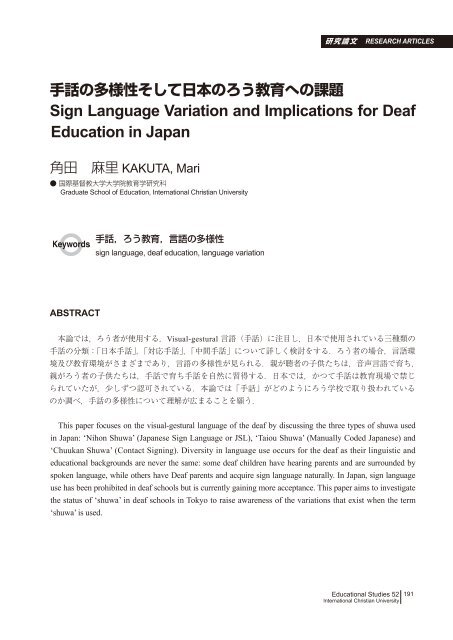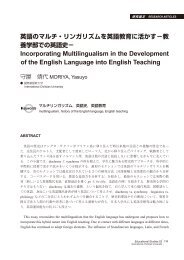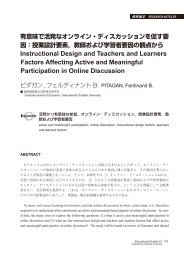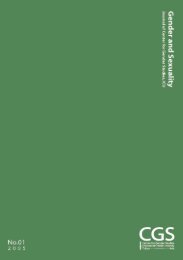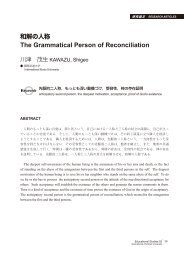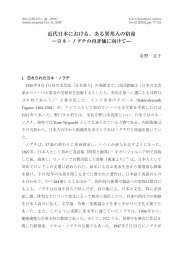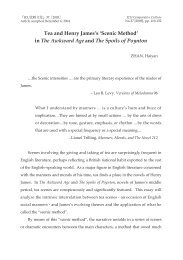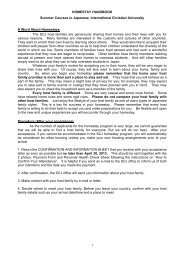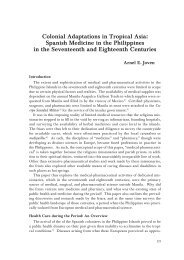Sign Language Variation and Implications for Deaf Education in Japan
Sign Language Variation and Implications for Deaf Education in Japan
Sign Language Variation and Implications for Deaf Education in Japan
You also want an ePaper? Increase the reach of your titles
YUMPU automatically turns print PDFs into web optimized ePapers that Google loves.
研 究 論 文<br />
RESEARCH ARTICLES<br />
手 話 の 多 様 性 そして 日 本 のろう 教 育 への 課 題<br />
<strong>Sign</strong> <strong>Language</strong> <strong>Variation</strong> <strong>and</strong> <strong>Implications</strong> <strong>for</strong> <strong>Deaf</strong><br />
<strong>Education</strong> <strong>in</strong> <strong>Japan</strong><br />
角 田 麻 里 KAKUTA, Mari<br />
● 国 際 基 督 教 大 学 大 学 院 教 育 学 研 究 科<br />
Graduate School of <strong>Education</strong>, International Christian University<br />
手 話 ,ろう 教 育 , 言 語 の 多 様 性<br />
sign language, deaf education, language variation<br />
ABSTRACT<br />
Visual-gestural <br />
<br />
<br />
<br />
<br />
<br />
This paper focuses on the visual-gestural language of the deaf by discuss<strong>in</strong>g the three types of shuwa used<br />
<strong>in</strong> <strong>Japan</strong>: ‘Nihon Shuwa’ (<strong>Japan</strong>ese <strong>Sign</strong> <strong>Language</strong> or JSL), ‘Taiou Shuwa’ (Manually Coded <strong>Japan</strong>ese) <strong>and</strong><br />
‘Chuukan Shuwa’ (Contact <strong>Sign</strong><strong>in</strong>g). Diversity <strong>in</strong> language use occurs <strong>for</strong> the deaf as their l<strong>in</strong>guistic <strong>and</strong><br />
educational backgrounds are never the same: some deaf children have hear<strong>in</strong>g parents <strong>and</strong> are surrounded by<br />
spoken language, while others have <strong>Deaf</strong> parents <strong>and</strong> acquire sign language naturally. In <strong>Japan</strong>, sign language<br />
use has been prohibited <strong>in</strong> deaf schools but is currently ga<strong>in</strong><strong>in</strong>g more acceptance. This paper aims to <strong>in</strong>vestigate<br />
the status of ‘shuwa’ <strong>in</strong> deaf schools <strong>in</strong> Tokyo to raise awareness of the variations that exist when the term<br />
‘shuwa’ is used.<br />
<strong>Education</strong>al Studies 52<br />
International Christian University<br />
191
Introduction<br />
Three <strong>Variation</strong>s <strong>in</strong> ‘Shuwa’<br />
Most children <strong>in</strong> <strong>Japan</strong> learn <strong>and</strong> study <strong>in</strong> their<br />
first language. But there are children who cannot<br />
acquire <strong>Japan</strong>ese as their first language because they<br />
are deaf (‘deaf’ with a small ‘d’ will be used <strong>in</strong> a<br />
neutral manner while ‘<strong>Deaf</strong>’ with a capital ‘D’ refers<br />
to a l<strong>in</strong>guistic m<strong>in</strong>ority that uses sign language). The<br />
natural language <strong>for</strong> these children should be sign<br />
language but the <strong>Japan</strong>ese educational system <strong>in</strong>sists<br />
on the acquisition of <strong>Japan</strong>ese, thus depriv<strong>in</strong>g deaf<br />
children of their rights to learn <strong>in</strong> a visual language.<br />
Throughout history, the educational methods used<br />
to teach the deaf have varied. The current trend <strong>in</strong><br />
<strong>Japan</strong> is slowly shift<strong>in</strong>g towards the recognition that<br />
sign language should be used <strong>in</strong> deaf schools. In<br />
<strong>Japan</strong>, sign language is referred to as ‘shuwa’. On<br />
the surface, this is beneficial <strong>for</strong> deaf children, but<br />
a closer exam<strong>in</strong>ation of the term ‘shuwa’ <strong>and</strong> of its<br />
usage reveal that variations exist <strong>and</strong> that many types<br />
of ‘shuwa’ do not refer to the natural sign language<br />
of the deaf.<br />
The first half of this paper aims to look at<br />
variations <strong>in</strong> ‘shuwa’ to <strong>in</strong>vestigate how these<br />
variations may affect the education of the deaf. The<br />
term ‘shuwa’ is very broad <strong>and</strong> encompasses ‘Nihon<br />
Shuwa’ (<strong>Japan</strong>ese <strong>Sign</strong> <strong>Language</strong> or JSL), ‘Taiou<br />
Shuwa’ (Manually Coded <strong>Japan</strong>ese or language<br />
signed accord<strong>in</strong>g to <strong>Japan</strong>ese grammar) <strong>and</strong><br />
‘Chuukan Shuwa’ (Contact <strong>Sign</strong><strong>in</strong>g). These three<br />
dist<strong>in</strong>ctions are based on a model of sign language<br />
variation proposed earlier by Yazawa (1996, as cited<br />
<strong>in</strong> Nakamura, 2006). Note however that the term,<br />
‘Dentouteki Shuwa’, that Yazawa uses is referred to<br />
here as ‘Nihon Shuwa’ (JSL). The second half of this<br />
paper discusses these three types of sign variety <strong>for</strong><br />
deaf education <strong>in</strong> <strong>Japan</strong>.<br />
Nihon Shuwa (JSL)<br />
The natural language <strong>for</strong> the <strong>Deaf</strong> is called<br />
<strong>Japan</strong>ese <strong>Sign</strong> <strong>Language</strong> (JSL) (<strong>in</strong> <strong>Japan</strong>ese, ‘Nihon<br />
Shuwa’). Unlike spoken languages, sign languages<br />
use the visual-gestural modality. This characteristic<br />
of sign language resulted <strong>in</strong> many misconceptions<br />
that sign languages are only gestures <strong>and</strong> not<br />
language, <strong>and</strong> culm<strong>in</strong>ated <strong>in</strong> sign language be<strong>in</strong>g<br />
banned <strong>in</strong> deaf education.<br />
Research on American <strong>Sign</strong> <strong>Language</strong> (ASL)<br />
shows that sign languages are more iconic than<br />
spoken ones (Emmorey, 2002). S<strong>in</strong>ce sign languages<br />
are visual languages, many signs represent the<br />
object or th<strong>in</strong>gs be<strong>in</strong>g described. For example, when<br />
describ<strong>in</strong>g the appearance of a person, signers often<br />
give detailed traits of the person so that the viewer<br />
can actually visualize the person be<strong>in</strong>g discussed.<br />
If a signer is try<strong>in</strong>g to expla<strong>in</strong> that the person wears<br />
glasses, the sign <strong>for</strong> ‘glasses’ is made (with both<br />
h<strong>and</strong>s draw<strong>in</strong>g the l<strong>in</strong>e of the frame of glasses), then<br />
the signer actually draws the shape of the glasses<br />
near their eyes. If one needs to describe ‘the man<br />
is wear<strong>in</strong>g square-framed glasses’ <strong>in</strong> English, there<br />
is no iconic connection between the mean<strong>in</strong>gs of<br />
each word <strong>in</strong> the sentence. But <strong>in</strong> ASL, the sign that<br />
will have the mean<strong>in</strong>g of ‘squared-frame’ is similar<br />
to a gesture that actually draws the shape of the<br />
glasses. This was one of the characteristics of ASL<br />
that caused it to be perceived as not be<strong>in</strong>g a true<br />
language. Careful attention reveals that, although<br />
the signs <strong>for</strong> ‘glasses’ <strong>and</strong> ‘square-framed’ may look<br />
iconic, other signs, such as ‘man’ (signed with open<br />
h<strong>and</strong>s <strong>and</strong> the thumb touch<strong>in</strong>g the <strong>for</strong>ehead <strong>and</strong> the<br />
chest), do not have iconic images. The sign <strong>for</strong> man<br />
is arbitrary <strong>in</strong> its relationship to the actual mean<strong>in</strong>g.<br />
In JSL, ‘man’ is shown by the thumbs-up sign,<br />
<strong>in</strong>dicat<strong>in</strong>g that sign languages around the world are<br />
not universal.<br />
In the <strong>Japan</strong>ese context, people typically th<strong>in</strong>k that<br />
192<br />
<strong>Education</strong>al Studies 52<br />
International Christian University
JSL is ungrammatical because it has no particles.<br />
Ichida (2001) objects to this view <strong>and</strong> provides<br />
evidence that not all languages <strong>in</strong> the world have<br />
particles. Moreover, word-order <strong>and</strong> Non-Manual<br />
<strong>Sign</strong>als (NMS) (such as head movement, eye/<br />
eyebrow movement, mouth<strong>in</strong>g <strong>and</strong> eye gaze) have<br />
important grammatical roles <strong>in</strong> JSL. For example,<br />
one can make different types of questions by<br />
chang<strong>in</strong>g the head placement (like tilt<strong>in</strong>g the head<br />
<strong>for</strong>ward).<br />
Ichida (2001) describes many l<strong>in</strong>guistic aspects<br />
of JSL <strong>and</strong> clearly states that JSL is a language. He<br />
believes problems have arisen <strong>in</strong> deaf education<br />
because hear<strong>in</strong>g teachers are not aware that their<br />
students have such a complex language <strong>and</strong> teachers<br />
th<strong>in</strong>k they have to teach the children ‘shuwa’ <strong>in</strong>stead<br />
of teach<strong>in</strong>g <strong>in</strong> ‘shuwa’.<br />
Taiou Shuwa<br />
<strong>Japan</strong>ese <strong>Sign</strong> <strong>Language</strong> is a language <strong>for</strong> the <strong>Deaf</strong><br />
that developed naturally, but manually coded signs<br />
exist also that were <strong>in</strong>vented artificially to follow the<br />
grammar of <strong>Japan</strong>ese to support spoken language<br />
development. S<strong>in</strong>ce most deaf school teachers are<br />
hear<strong>in</strong>g, it is <strong>in</strong>evitable that they speak <strong>and</strong> sign at<br />
the same time.<br />
When the <strong>Deaf</strong> adapts to the hear<strong>in</strong>g, it is usually<br />
<strong>in</strong> the <strong>for</strong>m of Taiou Shuwa, which means that<br />
the signs used <strong>in</strong> JSL are arranged <strong>in</strong> the order<br />
of spoken <strong>Japan</strong>ese, so that it is easier <strong>for</strong> the<br />
hear<strong>in</strong>g to underst<strong>and</strong>. Are these signed systems<br />
languages? Bos (1994) states that signed languages<br />
are unnatural <strong>and</strong> are not real languages. They are<br />
artificial as they try to fit the signs of sign languages<br />
<strong>in</strong>to the grammar of spoken ones. In the English<br />
sett<strong>in</strong>g, Strong (1988) also makes clear that signed<br />
systems used <strong>in</strong> a classroom that advocates the<br />
Total Communication Approach (an approach that<br />
believes that any <strong>for</strong>m of communication mode can<br />
be used to communicate with the deaf) is an artificial<br />
code used to represent English <strong>in</strong> a visual-gestural<br />
mode. Stevens (1980) cautions teachers of the deaf<br />
not to use Manually Coded English (MCE) as a tool<br />
to teach language but as a tool <strong>for</strong> communication<br />
that may lead to language learn<strong>in</strong>g. Accord<strong>in</strong>g to<br />
Supalla (1991), MCE is different from ASL <strong>and</strong><br />
lacks the language component of ASL because it<br />
does not have the modality constra<strong>in</strong>ts that ASL has.<br />
To prove this hypothesis, Supalla (1991) observed<br />
deaf children <strong>in</strong> an MCE-based educational sett<strong>in</strong>g.<br />
The children did not use MCE <strong>and</strong> case mark<strong>in</strong>gs<br />
of English were miss<strong>in</strong>g from their communication<br />
mode. The question of different modalities <strong>in</strong> spoken<br />
<strong>and</strong> sign language <strong>and</strong> the possibility of actually<br />
transferr<strong>in</strong>g a spoken language to a signed system<br />
was raised <strong>in</strong> this study.<br />
Torigoe (1996) provides reasons <strong>for</strong> why such a<br />
system has spread <strong>in</strong> <strong>Japan</strong>. In sign language circles<br />
<strong>and</strong> sign language courses offered by the municipal<br />
governments <strong>in</strong> <strong>Japan</strong>, the textbooks are <strong>in</strong> <strong>Japan</strong>ese,<br />
provid<strong>in</strong>g an advantageous situation <strong>for</strong> hear<strong>in</strong>g<br />
teachers. Thus the so-called ‘shuwa’ learned <strong>in</strong> <strong>Japan</strong><br />
is mostly ‘Taiou Shuwa’ <strong>and</strong> heavily <strong>in</strong>fluenced by<br />
<strong>Japan</strong>ese word order.<br />
In the Declaration of the <strong>Deaf</strong> that promoted the<br />
<strong>Deaf</strong> as a l<strong>in</strong>guistic m<strong>in</strong>ority, Kimura <strong>and</strong> Ichida<br />
(1995) used the term SimCom (abbreviation <strong>for</strong><br />
simultaneous communication) to describe how<br />
the hear<strong>in</strong>g would produce signs as they spoke<br />
or mouthed <strong>Japan</strong>ese utterances. One of the ma<strong>in</strong><br />
po<strong>in</strong>ts <strong>in</strong> the Declaration of the <strong>Deaf</strong> is that a clear<br />
dist<strong>in</strong>ction between those who are deaf, hard of<br />
hear<strong>in</strong>g <strong>and</strong> adventitiously deafened should be made<br />
as <strong>Deaf</strong> people prefer JSL while hard of hear<strong>in</strong>g ones<br />
prefer SimCom (as outl<strong>in</strong>ed <strong>in</strong> Quay <strong>and</strong> Rackham,<br />
1999).<br />
Municipal governments, however, have not<br />
made such dist<strong>in</strong>ctions <strong>in</strong> their many sign language<br />
class offer<strong>in</strong>gs. When people f<strong>in</strong>ish such classes<br />
offered mostly free of charge, they believe that<br />
they have acquired JSL. Most of the time, their<br />
sign<strong>in</strong>g is heavily <strong>in</strong>fluenced by <strong>Japan</strong>ese grammar<br />
<strong>Education</strong>al Studies 52<br />
International Christian University<br />
193
as they usually speak <strong>and</strong> sign at the same time<br />
(SimCom). When these people <strong>in</strong>terpret <strong>for</strong> the <strong>Deaf</strong><br />
they believe that their sign<strong>in</strong>g is ‘better’ <strong>and</strong> more<br />
‘correct’.<br />
<strong>Sign</strong> language classes <strong>in</strong> Musash<strong>in</strong>o city,<br />
<strong>for</strong> example, consist of four levels: beg<strong>in</strong>ner,<br />
<strong>in</strong>termediate, advanced <strong>and</strong> <strong>in</strong>terpreter tra<strong>in</strong><strong>in</strong>g.<br />
Up until the advanced class, there is always a<br />
pair of <strong>in</strong>structors where one is deaf <strong>and</strong> one is<br />
hear<strong>in</strong>g. But the f<strong>in</strong>al tra<strong>in</strong><strong>in</strong>g class <strong>for</strong> <strong>in</strong>terpreters<br />
is taught only by a hear<strong>in</strong>g <strong>in</strong>structor. Members of<br />
<strong>Deaf</strong> Associations may also not all use JSL. Some<br />
may have grown up with a cochlear implant, <strong>and</strong><br />
some may have gone to hear<strong>in</strong>g schools <strong>and</strong> learnt<br />
sign<strong>in</strong>g later on <strong>in</strong> their life. These members of the<br />
deaf community are more likely to use SimCom or<br />
Contact <strong>Sign</strong><strong>in</strong>g than JSL.<br />
Nakamura (2006) discusses the political clash<br />
between the <strong>Japan</strong>ese Federation of the <strong>Deaf</strong> (JFD)<br />
<strong>and</strong> D-Pro (a group that strongly supports the<br />
Declaration of the <strong>Deaf</strong>) about the use of new signs<br />
<strong>and</strong> the acceptance of these signs <strong>in</strong> the vocabulary<br />
of JSL. Many hear<strong>in</strong>g <strong>in</strong>terpreters learn new signs<br />
from JFD, but the <strong>Deaf</strong> themselves do not recognize<br />
these signs. JSL versus SimCom is an on-go<strong>in</strong>g<br />
debate due to the diversity of language backgrounds<br />
of the deaf. Depend<strong>in</strong>g on the city, the situation<br />
varies. More deaf people us<strong>in</strong>g the natural approach<br />
are now becom<strong>in</strong>g sign language <strong>in</strong>structors so the<br />
situation may change <strong>in</strong> <strong>Japan</strong>. But the fact rema<strong>in</strong>s<br />
that many <strong>in</strong>terpreters still use ‘Taiou Shuwa’ with<br />
the <strong>Deaf</strong>. Also <strong>in</strong> the deaf schools, Hashiba (2006),<br />
a <strong>Deaf</strong> parent, has po<strong>in</strong>ted out that although deaf<br />
schools say that they use ‘shuwa’ most of the time,<br />
it is ‘Taiou Shuwa’, an artificial language that is<br />
difficult <strong>for</strong> deaf children to underst<strong>and</strong>.<br />
Chuukan Shuwa or Contact <strong>Sign</strong><strong>in</strong>g<br />
‘Chuukan Shuwa’ is the third type of sign<strong>in</strong>g that<br />
can be found <strong>in</strong> the <strong>Japan</strong>ese sett<strong>in</strong>g. ‘Chuukan’ can<br />
be translated as ‘<strong>in</strong> between’ or ‘<strong>in</strong> the middle’. In<br />
research on the <strong>Deaf</strong> <strong>in</strong> the U.S.A., the term, ‘contact<br />
sign<strong>in</strong>g’, is equivalent to ‘Chuukan Shuwa’ so it will<br />
hence<strong>for</strong>th be referred to as contact sign<strong>in</strong>g.<br />
Contact sign<strong>in</strong>g is used when there is language<br />
contact between different signers <strong>and</strong>/or different<br />
hear<strong>in</strong>g signers (Mess<strong>in</strong>g, 1999). It is also called<br />
pidg<strong>in</strong> signs. Pidg<strong>in</strong> signs <strong>for</strong>m when there is<br />
<strong>in</strong>teraction between people of different backgrounds<br />
with different language abilities. S<strong>in</strong>ce deaf people<br />
are raised <strong>in</strong> different environments, the dom<strong>in</strong>ant<br />
language or communication mode differs from<br />
person to person. Knight <strong>and</strong> Swanwick (1999)<br />
describe pidg<strong>in</strong> signs as a communication mode<br />
exist<strong>in</strong>g <strong>in</strong> between sign languages <strong>and</strong> spoken <strong>and</strong><br />
written languages.<br />
Def<strong>in</strong><strong>in</strong>g this type of sign<strong>in</strong>g is complicated by<br />
the fact that manual codes of the spoken language<br />
exist as well. There is no clear identifiable po<strong>in</strong>t on<br />
a cont<strong>in</strong>uum between sign <strong>and</strong> spoken languages to<br />
place pidg<strong>in</strong> signs.<br />
Lucas <strong>and</strong> Valli (1990), <strong>in</strong> describ<strong>in</strong>g pidg<strong>in</strong> signs<br />
as contact sign<strong>in</strong>g, list possible contact situations <strong>for</strong><br />
the American deaf community as follows:<br />
· deaf bil<strong>in</strong>guals with hear<strong>in</strong>g bil<strong>in</strong>guals<br />
· deaf bil<strong>in</strong>guals with deaf bil<strong>in</strong>guals<br />
· deaf bil<strong>in</strong>guals with hear<strong>in</strong>g spoken-English<br />
monol<strong>in</strong>guals<br />
· hear<strong>in</strong>g bil<strong>in</strong>guals with deaf English signers<br />
· deaf bil<strong>in</strong>guals with deaf English signers<br />
· deaf English signers with hear<strong>in</strong>g spoken-<br />
English monol<strong>in</strong>guals<br />
· deaf English signers with hear<strong>in</strong>g bil<strong>in</strong>guals<br />
· deaf English signers with deaf ASL monol<strong>in</strong>guals<br />
· deaf bil<strong>in</strong>guals with deaf ASL monol<strong>in</strong>guals<br />
· deaf ASL monol<strong>in</strong>guals with hear<strong>in</strong>g bil<strong>in</strong>guals<br />
Pidg<strong>in</strong> sign<strong>in</strong>g or contact sign<strong>in</strong>g can occur <strong>in</strong><br />
these situations. When the deaf <strong>in</strong>teract with hear<strong>in</strong>g<br />
people, they tend to shift away from ASL (Lucas <strong>and</strong><br />
Valli, 1990). By try<strong>in</strong>g to make adaptations, ASL<br />
signs tend to be signed <strong>in</strong> English word order.<br />
The discussion of the situation <strong>in</strong> the American<br />
194<br />
<strong>Education</strong>al Studies 52<br />
International Christian University
sett<strong>in</strong>g can also be applied to the <strong>Japan</strong>ese sett<strong>in</strong>g.<br />
The type of language produced between a sign <strong>and</strong><br />
spoken language is equivalent to what the <strong>Japan</strong>ese<br />
refer to as ‘Chuukan Shuwa’. It is more complex<br />
than what can be <strong>in</strong>dicated by a l<strong>in</strong>ear cont<strong>in</strong>uum<br />
as different factors such as age, gender, place where<br />
sign language is learnt, can result <strong>in</strong> many variations.<br />
Researchers of sign language criticize the broad<br />
mean<strong>in</strong>g of ‘Chuukan Shuwa’ as some contact<br />
sign<strong>in</strong>g may be closer to spoken language, <strong>and</strong> some<br />
may be closer to sign language) (K<strong>and</strong>a, 1996; Saito,<br />
2007). ‘Chuukan Shuwa’ rema<strong>in</strong>s an ill-def<strong>in</strong>ed<br />
category <strong>and</strong> more research is needed <strong>in</strong> this area<br />
be<strong>for</strong>e we can underst<strong>and</strong> its place as a type of sign<br />
language variation <strong>in</strong> <strong>Japan</strong>.<br />
The Status of ‘Shuwa’ <strong>in</strong> <strong>Deaf</strong> Schools <strong>in</strong><br />
<strong>Japan</strong><br />
What is the status of ‘shuwa’ at deaf schools <strong>in</strong><br />
<strong>Japan</strong>? Accord<strong>in</strong>g to Ichida (2004), deaf schools are<br />
important because they provide a community <strong>for</strong> the<br />
<strong>Deaf</strong> where they can <strong>in</strong>teract <strong>in</strong> sign language. When<br />
deaf children are <strong>in</strong>tegrated <strong>in</strong>to hear<strong>in</strong>g schools,<br />
they may become semi-l<strong>in</strong>gual by not be<strong>in</strong>g able to<br />
speak nor sign. Without sign language <strong>in</strong>put, these<br />
children cannot develop a complete language. In<br />
Tokyo, due to changes <strong>in</strong> the education system, there<br />
are only four public deaf schools <strong>and</strong> two private<br />
ones. One private school <strong>in</strong> Tokyo is an Oral School<br />
which will not be discussed further. Each deaf school<br />
has a homepage on the <strong>in</strong>ternet <strong>and</strong> their school<br />
goals are exam<strong>in</strong>ed to see the status of ‘shuwa’ <strong>in</strong> the<br />
different schools.<br />
The Ootsuka Public School <strong>for</strong> the <strong>Deaf</strong> lists two<br />
separate goals <strong>for</strong> deaf children with <strong>and</strong> without<br />
other disabilities. K<strong>in</strong>dergarten children without<br />
multiple disabilities:<br />
Use many k<strong>in</strong>ds of communication methods<br />
such as residual hear<strong>in</strong>g, oral method, ‘shuwa’<br />
[underl<strong>in</strong>ed on the orig<strong>in</strong>al below], f<strong>in</strong>ger<br />
spell<strong>in</strong>g <strong>and</strong> gesture to suit <strong>in</strong>dividual needs.<br />
Also through experiences where the students<br />
can underst<strong>and</strong> each other, the basis of<br />
communication, the concept of language is<br />
acquired thus lead<strong>in</strong>g to the development of the<br />
basis <strong>for</strong> <strong>Japan</strong>ese.<br />
[My translation of:<br />
<br />
<br />
<br />
<br />
<br />
] (Source: http://www.<br />
otsuka-sd.metro.tokyo.jp/otsuka/otsuka.html)<br />
The above statement shows that the educational<br />
goal <strong>for</strong> deaf children without multiple disabilities<br />
is the acquisition of <strong>Japan</strong>ese, <strong>and</strong> ‘shuwa’ is only<br />
a supplementary tool to support this. The word<br />
‘kotoba’ (language/word), is used <strong>in</strong> the school’s<br />
goals later on but it rema<strong>in</strong>s unclear whether it is<br />
spoken <strong>Japan</strong>ese or <strong>Japan</strong>ese <strong>Sign</strong> <strong>Language</strong>. The<br />
objectives <strong>for</strong> primary school are the same as <strong>for</strong><br />
the k<strong>in</strong>dergarten. As the language <strong>for</strong> classroom<br />
<strong>in</strong>struction, this school clearly states that they use<br />
mostly ‘Chuukan Shuwa’ <strong>in</strong> the classes. On their<br />
homepage, they <strong>in</strong>troduce three types of ‘shuwa’-<br />
‘Nihongo Taiou Shuwa’, ‘Chuukan Shuwa’ <strong>and</strong><br />
‘Nihon Shuwa’ - <strong>and</strong> describe the characteristics<br />
of each types. The grammatical characteristics<br />
of ‘Nihongo Taiou shuwa’ <strong>and</strong> ‘Nihon Shuwa’<br />
are the same as what have been discussed <strong>in</strong> the<br />
previous sections. But this school clearly def<strong>in</strong>es<br />
the mean<strong>in</strong>g of “Chuukan Shuwa” as mostly<br />
follow<strong>in</strong>g <strong>Japan</strong>ese grammar along with mouth<strong>in</strong>g<br />
the <strong>Japan</strong>ese morpheme that comes with each sign.<br />
The def<strong>in</strong>ition of ‘Chuukan Shuwa’ is somewhat<br />
close to SimCom <strong>and</strong> this def<strong>in</strong>ition is relevant <strong>in</strong> the<br />
deaf school sett<strong>in</strong>g as most teachers of the deaf are<br />
hear<strong>in</strong>g <strong>and</strong> are dom<strong>in</strong>ant <strong>in</strong> the spoken language.<br />
After def<strong>in</strong><strong>in</strong>g the different types of ‘shuwa’, the<br />
pros <strong>and</strong> cons of us<strong>in</strong>g ‘shuwa’ <strong>in</strong> the school are<br />
<strong>Education</strong>al Studies 52<br />
International Christian University<br />
195
listed. The advantages of us<strong>in</strong>g ‘shuwa’ are that it is<br />
very expressive <strong>and</strong> can help early communication<br />
between mother <strong>and</strong> child. Also learn<strong>in</strong>g ‘shuwa’<br />
can raise the self-esteem of the students <strong>and</strong> raise<br />
their pride <strong>in</strong> be<strong>in</strong>g <strong>Deaf</strong>. S<strong>in</strong>ce ‘shuwa’ is used <strong>in</strong><br />
a broad sense here, the use of ‘shuwa’ as a <strong>for</strong>m of<br />
Total Communication (an eclectic method allow<strong>in</strong>g<br />
all types of communication modes to achieve<br />
efficient communication) is considered as an<br />
advantage. On the other h<strong>and</strong>, they state that one of<br />
the disadvantages of ‘shuwa’ is that it cannot show<br />
<strong>Japan</strong>ese sounds <strong>and</strong> does not have a written <strong>for</strong>m.<br />
Other disadvantages are limitations of vocabulary<br />
<strong>and</strong> limitation when communicat<strong>in</strong>g with hear<strong>in</strong>g<br />
people (as not everyone can use ‘shuwa’). This<br />
typically shows that the f<strong>in</strong>al aim <strong>for</strong> deaf students is<br />
to <strong>in</strong>tegrate with the hear<strong>in</strong>g.<br />
Chuuou <strong>Deaf</strong> School has a junior high <strong>and</strong> high<br />
school <strong>and</strong> does not specify <strong>in</strong> their objectives the<br />
use of sign language but <strong>in</strong>dicates as their goal,<br />
the cultivation of communication <strong>and</strong> expressive<br />
skills that will help deaf students to enter university.<br />
What this ‘communication skill’ encompasses<br />
rema<strong>in</strong>s unclear but is most likely to be <strong>Japan</strong>ese<br />
rather than sign language. In the ‘Address by the<br />
Pr<strong>in</strong>cipal’, ‘shuwa’ is considered to provide access<br />
to <strong>in</strong><strong>for</strong>mation along with note-tak<strong>in</strong>g <strong>and</strong> is thereby<br />
useful as a secondary tool to develop deaf students’<br />
knowledge of the world.<br />
Tachikawa <strong>Deaf</strong> School with k<strong>in</strong>dergarten to high<br />
school sections does not state specific educational<br />
goals on their homepage. Goals related to language<br />
are only referred to <strong>in</strong> junior high, stat<strong>in</strong>g that they<br />
aim <strong>for</strong> students who can underst<strong>and</strong> their disability<br />
<strong>and</strong> overcome it with language <strong>and</strong> learn<strong>in</strong>g skills.<br />
‘<strong>Language</strong>’ seems to be used <strong>in</strong> a very general term<br />
similar to the word ‘kotoba’ used by the Ootsuka<br />
<strong>Deaf</strong> School. The implication aga<strong>in</strong> po<strong>in</strong>ts towards<br />
the acquisition of the oral rather than the visual<br />
language.<br />
Katsushika <strong>Deaf</strong> School with k<strong>in</strong>dergarten to<br />
high school sections also does not use the term<br />
‘shuwa’ but clearly states <strong>for</strong> their primary school<br />
that their goal is to develop communication skills<br />
<strong>and</strong> <strong>Japan</strong>ese ability. They add though that they<br />
support the use of ‘shuwa’ to decrease <strong>in</strong><strong>for</strong>mation<br />
deficiency. Thus ‘shuwa’ aga<strong>in</strong> plays a secondary<br />
role as at the Chuuou <strong>Deaf</strong> School.<br />
Look<strong>in</strong>g at the educational objectives of<br />
public deaf schools <strong>in</strong> Tokyo, the term ‘shuwa’ is<br />
surpris<strong>in</strong>gly used less frequently than expected<br />
<strong>and</strong> detailed educational methods are not stated.<br />
Kanazawa (2001) po<strong>in</strong>ts out that many people often<br />
use the term ‘Kouwa hou’ <strong>for</strong> the Oral Method <strong>and</strong><br />
‘Shuwa hou’ <strong>for</strong> the <strong>Sign</strong> <strong>Language</strong> Method without<br />
clearly def<strong>in</strong><strong>in</strong>g each method. Some people may<br />
use ‘Shuwa hou’ to refer to the use of some signs<br />
to supplement speech while others may consider<br />
‘Shuwa hou’ to refer to teach<strong>in</strong>g all classes <strong>in</strong> JSL. In<br />
<strong>Japan</strong>, us<strong>in</strong>g some signs to supplement speech dur<strong>in</strong>g<br />
the early development phase (a so-called ‘Shuwahou’)<br />
is sometimes considered only as a <strong>for</strong>m of<br />
communication rather than of language as can be<br />
<strong>in</strong>ferred from the school goals. Kanazawa (2001)<br />
<strong>in</strong>dicates that sometimes, ‘Shuwa-hou’ is considered<br />
to support ‘Kouwa-hou’. That is, children learn how<br />
to communicate <strong>in</strong> the early years us<strong>in</strong>g some signs<br />
but are slowly shifted towards the use of spoken<br />
language.<br />
In the past, the use of ‘shuwa’ has been prohibited<br />
<strong>in</strong> the deaf schools but students are now allowed to<br />
sign <strong>in</strong> schools. The current problem <strong>in</strong> the schools<br />
is that most teachers of the deaf are hear<strong>in</strong>g <strong>and</strong> have<br />
hardly any background tra<strong>in</strong><strong>in</strong>g <strong>in</strong> deaf education.<br />
Sasaki (2006) has a strong view that most teachers at<br />
public deaf schools use ‘Taiou Shuwa’ <strong>and</strong> this type<br />
of sign<strong>in</strong>g is not useful <strong>for</strong> the language development<br />
of the deaf. Sasaki expla<strong>in</strong>s that teachers do not<br />
have enough time to acquire sign language <strong>and</strong> the<br />
rotation system prevents teachers from stay<strong>in</strong>g at<br />
deaf schools long enough to master how to teach the<br />
deaf. Ueno (2003) categorized two types of sign<strong>in</strong>g<br />
196<br />
<strong>Education</strong>al Studies 52<br />
International Christian University
<strong>in</strong> terms of their relationship to deaf education:<br />
‘Taiou Shuwa’ is used <strong>in</strong> deaf schools follow<strong>in</strong>g<br />
the Total Communication Approach, while JSL is<br />
used <strong>in</strong> Bil<strong>in</strong>gual-Bicultural <strong>Education</strong>. Although<br />
‘Chuukan Shuwa’ is used to describe the language of<br />
<strong>in</strong>struction, many deaf schools have not fully shifted<br />
from Total Communication as at the Ootsuka <strong>Deaf</strong><br />
School.<br />
With a new focus on Special Needs <strong>Education</strong>,<br />
deaf schools are <strong>in</strong> danger of closure (Quay, 2005).<br />
Students are decreas<strong>in</strong>g <strong>and</strong> those with multiple<br />
disabilities are enter<strong>in</strong>g deaf schools. As deaf<br />
education is be<strong>in</strong>g threatened by new educational<br />
re<strong>for</strong>ms, a private school <strong>for</strong> the <strong>Deaf</strong> that uses<br />
<strong>Japan</strong>ese <strong>Sign</strong> <strong>Language</strong> started <strong>in</strong> Tokyo <strong>in</strong> April<br />
2008. Meisei Gakuen is the first <strong>Deaf</strong> school <strong>in</strong><br />
<strong>Japan</strong> to adopt the bil<strong>in</strong>gual-bicultural approach to<br />
teach <strong>Deaf</strong> children. Students are taught <strong>in</strong> JSL <strong>and</strong><br />
they learn how to read <strong>and</strong> write <strong>in</strong> <strong>Japan</strong>ese. Unlike<br />
the public schools, Meisei clearly states their use of<br />
JSL <strong>in</strong> the classrooms. This school has just started so<br />
research still needs to be conducted on the use of JSL<br />
<strong>and</strong> the development of written <strong>Japan</strong>ese.<br />
Conclusion<br />
This paper looked at three ways of sign<strong>in</strong>g<br />
(‘shuwa’) <strong>in</strong> <strong>Japan</strong>. Out of these three types, only<br />
JSL is the natural <strong>and</strong> pure language <strong>for</strong> the <strong>Deaf</strong>.<br />
The other two ‘shuwa’ have developed through<br />
<strong>in</strong>teractions between deaf <strong>and</strong> hear<strong>in</strong>g people. Many<br />
deaf students have different backgrounds <strong>and</strong> this<br />
complicates the educational situation <strong>for</strong> the deaf.<br />
Those with hear<strong>in</strong>g parents may not learn sign<br />
language until they meet <strong>Deaf</strong> peers. Those with<br />
<strong>Deaf</strong> parents may acquire a sign language from birth.<br />
In the previous section, the status of ‘shuwa’<br />
<strong>in</strong> deaf schools has been discussed. For hear<strong>in</strong>g<br />
teachers, because of the school system, it is hard<br />
<strong>for</strong> them to acquire JSL <strong>and</strong> most teachers sign <strong>and</strong><br />
speak at the same time (SimCom). Unless more deaf<br />
teachers are hired, this problem cannot be solved.<br />
Also some students may have gone to hear<strong>in</strong>g<br />
schools <strong>and</strong> feel more com<strong>for</strong>table us<strong>in</strong>g <strong>Japan</strong>esebased<br />
sign<strong>in</strong>g. JSL is the language <strong>for</strong> the <strong>Deaf</strong> <strong>and</strong><br />
this cannot be denied. However, when it comes to<br />
deaf education, what is most important is <strong>for</strong> teachers<br />
to underst<strong>and</strong> the <strong>for</strong>m of sign<strong>in</strong>g their students feel<br />
the most com<strong>for</strong>table us<strong>in</strong>g. None of these three<br />
ways of sign<strong>in</strong>g is wrong if used by the deaf, so it<br />
is crucial that teachers are aware of the differences<br />
<strong>and</strong> respect the ‘shuwa’ their students are us<strong>in</strong>g <strong>and</strong><br />
do not treat it as ‘<strong>in</strong>correct’. In order to def<strong>in</strong>e each<br />
type of sign<strong>in</strong>g precisely, a closer analysis of sign<br />
<strong>in</strong>teractions is necessary as the parameters used thus<br />
far to def<strong>in</strong>e the three types of “shuwa” still rema<strong>in</strong><br />
very broad. Only by underst<strong>and</strong><strong>in</strong>g the dist<strong>in</strong>ctions<br />
between sign variations can we beg<strong>in</strong> to underst<strong>and</strong><br />
the richness <strong>and</strong> diversity of the <strong>Japan</strong>ese deaf<br />
community <strong>and</strong> culture.<br />
References<br />
Bos, H. F. (1994). Pre-l<strong>in</strong>gual deafness, sign<br />
language, <strong>and</strong> language acquisition. In B. Van<br />
der Bogaerde, H. Knoors, & M. Verrips, (Eds.),<br />
<strong>Language</strong> Acquisition with non-native <strong>in</strong>put:<br />
The acquisition of SLN (pp.11–29). Amsterdam:<br />
University of Amsterdam.<br />
Chuuou <strong>Deaf</strong> School. Gakkou kyouiku Mokuhyou<br />
[School teach<strong>in</strong>g goals].<br />
Retrieved June 3, 2009, from<br />
http://www.chuo-sd.metro.tokyo.jp/sub%20<br />
page/gakko%20gaiyou/kyouiku-mokuhyou.<br />
html<br />
Emmorey, K. (2002). <strong>Language</strong>, Cognition, <strong>and</strong> the<br />
Bra<strong>in</strong>. London: Lawrence Erlbaum Associates.<br />
Hashiba, Y. (2006). Nihon shuwa wa rousha no<br />
tamashii [JSL is the spirit of the <strong>Deaf</strong>].<br />
In Y. Kojima (Ed.), Roukyouiku ga Kawaru:<br />
Nichibenren [Ikensho] to Bair<strong>in</strong>garu Kyouiku e<br />
no Teigen [<strong>Deaf</strong> <strong>Education</strong> is go<strong>in</strong>g to change:<br />
Op<strong>in</strong>ion sent to the Bar Association <strong>and</strong><br />
Proposal <strong>for</strong> language education] (pp.41–62).<br />
Tokyo: Akashi shoten.<br />
Ichida, Y. (2001). Roukyouiku wa Shuwa o Gengo<br />
toshite n<strong>in</strong>chi dekiruka [Can <strong>Deaf</strong> education<br />
recognize sign language as a language]. In T.<br />
Kanazawa (Ed.), Roukyouiku no Datsukouchiku<br />
<strong>Education</strong>al Studies 52<br />
International Christian University<br />
197
[Re-structur<strong>in</strong>g <strong>Deaf</strong> <strong>Education</strong>] (pp.113–141).<br />
Tokyo: Akashi Shobo.<br />
Ichida, Y. (2004). Gengogaku kara mita Nihon shuwa<br />
[Look<strong>in</strong>g at JSL l<strong>in</strong>guistically]. In I. Kojima (Ed.),<br />
Roukyouiku to Gengoken [<strong>Deaf</strong> <strong>Education</strong> <strong>and</strong><br />
<strong>Language</strong> Rights] (pp.9–46). Tokyo: Akashi<br />
Shobo.<br />
Kanazawa, T. (2001). Roukyouiku no Paradaimu<br />
Tenkan [Paradigm shift <strong>in</strong> <strong>Deaf</strong> education]. In<br />
T. Kanazawa (Ed.), Roukyouiku no Datsukouchiku<br />
[Re-structur<strong>in</strong>g <strong>Deaf</strong> <strong>Education</strong>] (pp.11–41).<br />
Tokyo: AkashiShobo.<br />
K<strong>and</strong>a, K. (1996). Shuwagaku no zentei [Assumptions<br />
<strong>for</strong> sign language studies]. In K. K<strong>and</strong>a & N,<br />
Fuj<strong>in</strong>o (Eds.), Kiso kara no shuwagaku [<strong>Sign</strong><br />
language studies from the basics] (pp.32–42).<br />
Tokyo: Fukumura Shuppan.<br />
Katsushika <strong>Deaf</strong> School. Honkou no Gaiyou [Outl<strong>in</strong>e<br />
of the School].<br />
Retrieved June 3, 2009 from<br />
http://www.katsushika-sd.metro.tokyo.jp<br />
Kimura, H. <strong>and</strong> Ichida, Y. (1995). Rou Bunka sengen:<br />
gengoteki shousuuha to shite no Rousha [A<br />
Declaration of <strong>Deaf</strong> Culture: <strong>Deaf</strong> people as a<br />
L<strong>in</strong>guistic M<strong>in</strong>ority]. Gendai Shiso, 23 (3), 354–<br />
399.<br />
Knight, P. <strong>and</strong> Swanwick, R. (1999). The Care <strong>and</strong><br />
<strong>Education</strong> of a <strong>Deaf</strong> Child: A book <strong>for</strong> parents.<br />
Clevedon: Multil<strong>in</strong>gual Matters.<br />
Lucas, C. <strong>and</strong> Valli, C. (1990). ASL, English <strong>and</strong><br />
Contact <strong>Sign</strong><strong>in</strong>g. In C. Lucas (Ed.), <strong>Sign</strong><br />
<strong>Language</strong> Research: Theoretical Issues<br />
(pp.288–307). Wash<strong>in</strong>gton: Gallaudet<br />
University Press.<br />
Meisei Gakuen. Kyouiku R<strong>in</strong>en Kyoikuhouhou<br />
[Teach<strong>in</strong>g Pr<strong>in</strong>ciples <strong>and</strong> Methods]<br />
Retrieved June 3, 2009 from<br />
http://www.tachikawa-sd.metro.tokyo.jp/jhs/<br />
<strong>in</strong>dex.htm<br />
Mess<strong>in</strong>g, L. S. (1999). Introduction. In L. S. Mess<strong>in</strong>g<br />
<strong>and</strong> R. Campbell (Eds.), Gesture, Speech, <strong>and</strong><br />
<strong>Sign</strong> (pp.XIX–XXV). Ox<strong>for</strong>d: Ox<strong>for</strong>d University<br />
Press.<br />
Nakamura, K. (2006). <strong>Deaf</strong> <strong>in</strong> <strong>Japan</strong>: <strong>Sign</strong><strong>in</strong>g <strong>and</strong> the<br />
politics of identity. Ithaca: Cornell University<br />
Press.<br />
Ootsuka <strong>Deaf</strong> School. Kyouiku Mokuhyou [Teach<strong>in</strong>g<br />
goals].<br />
Retrieved June 3, 2009 from<br />
http://www.otsuka-sd.metro.tokyo.jp/otsuka/<br />
otsuka05.html<br />
Ootsuka <strong>Deaf</strong> School. Shuwa ni tsuite [About sign<br />
language].<br />
Retrieved June 3, 2009 from<br />
http://www.otsuka-sd.metro.tokyo.jp/otsuka/<br />
otsuka05.html<br />
Quay, S. (2005). <strong>Education</strong>al re<strong>for</strong>ms <strong>and</strong> English<br />
teach<strong>in</strong>g <strong>for</strong> the deaf <strong>in</strong> <strong>Japan</strong>. <strong>Deaf</strong>ness <strong>and</strong><br />
<strong>Education</strong> International 7(3), 138–152.<br />
Quay, S. <strong>and</strong> Rackham, D.W. (1999). <strong>Deaf</strong> Culture<br />
<strong>in</strong> <strong>Japan</strong>: A <strong>Language</strong> Attitude Survey. The<br />
Journal of Social Science, 40, 37–55.<br />
Saito, K. (2007). Shousuugengo toshite no shuwa<br />
[<strong>Sign</strong> language as a m<strong>in</strong>ority language]. Tokyo:<br />
Tokyo Daigaku Shuppan Kai.<br />
Sasaki, M. (2006). Rouji no Gengo Hattatsu to Kyoiku<br />
[<strong>Deaf</strong> childen’s <strong>Language</strong> Development <strong>and</strong><br />
<strong>Education</strong>]. In I. Kojima (Ed.), Roukyouiku ga<br />
Kawaru: Nichibenren[Ikensho] to Bair<strong>in</strong>garu<br />
Kyouiku e no Teigen [<strong>Deaf</strong> <strong>Education</strong> is go<strong>in</strong>g<br />
to change: Op<strong>in</strong>ion sent to the Bar Association<br />
<strong>and</strong> Proposal <strong>for</strong> language education] (pp.101–<br />
136). Tokyo, Akashi Shoten.<br />
Stevens, R.P. (1980). Children’s language should<br />
be learned, not taught. In William C. Stokoe<br />
(Ed.), <strong>Sign</strong> <strong>and</strong> Culture: A Reader <strong>for</strong> Students<br />
of American <strong>Sign</strong> <strong>Language</strong> (pp.206–216).<br />
Maryl<strong>and</strong>: L<strong>in</strong>stok Press.<br />
Strong, M. (1988). A bil<strong>in</strong>gual approach to educat<strong>in</strong>g<br />
deaf children. In Michael Strong (Ed.),<br />
<strong>Language</strong> Learn<strong>in</strong>g <strong>and</strong> <strong>Deaf</strong>ness (pp.3–47).<br />
Cambridge: Cambridge University Press.<br />
Tachikawa <strong>Deaf</strong> School. Gakkou Kyouiku Mokuhyou<br />
[School teach<strong>in</strong>g goals].<br />
Retrieved June 3, 2009 from<br />
http://www.tachikawa-sd.metro.tokyo.jp/jhs/<br />
<strong>in</strong>dex.htm<br />
Torigoe, T. (1996). Shuwa Gakushuu to Tsuyaku<br />
[<strong>Sign</strong> <strong>Language</strong> Learn<strong>in</strong>g <strong>and</strong> Interpret<strong>in</strong>g].<br />
In K. K<strong>and</strong>a & N. Fuj<strong>in</strong>o (Eds.), Kiso kara no<br />
Shuwagaku [Foundations of <strong>Sign</strong> <strong>Language</strong><br />
Studies] (pp.85–102). Tokyo, Fukumura<br />
Shuppan.<br />
Acknowledgement<br />
I would like to express profound gratitude to<br />
my advisor, Dr. Suzanne Quay <strong>for</strong> her <strong>in</strong>valuable<br />
support <strong>and</strong> supervision that guided me throughout<br />
my research. Funds from ICU COE program also<br />
enabled me to access many sources related to sign<br />
language.<br />
198<br />
<strong>Education</strong>al Studies 52<br />
International Christian University


